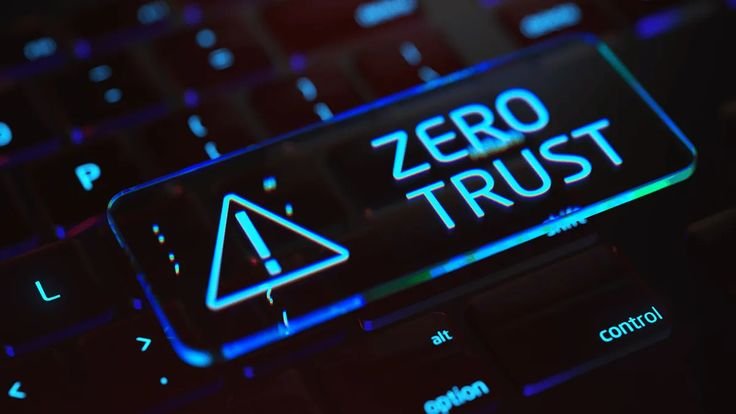
As the digital landscape grows increasingly complex, organizations are facing a rapidly evolving array of cyber threats. Traditional security models, which rely on perimeter-based defenses, are no longer sufficient to protect sensitive data and resources from sophisticated cyberattacks. Enter Zero Trust Security, a modern security framework designed to address these challenges by assuming that threats could be present both inside and outside the network. This article will explore what Zero Trust Security is, why it is important, and how organizations can implement it to protect their assets effectively.
1. What is Zero Trust Security?
Zero Trust Security is a cybersecurity model that operates on the principle of “never trust, always verify.” Unlike traditional security models that assume users and devices within a network can be trusted, Zero Trust takes a more cautious approach. It requires continuous verification of every user and device trying to access network resources, regardless of whether they are inside or outside the organization’s perimeter.
The Zero Trust model was first coined by John Kindervag, a former Forrester Research analyst, who argued that the inherent trust assumed within a traditional network perimeter is a significant vulnerability. In a Zero Trust architecture, every attempt to access network resources is treated as potentially hostile, and access is granted only after thorough verification.
2. Core Principles of Zero Trust Security
Zero Trust Security is built on several core principles that ensure comprehensive protection across the entire network. These principles include:
- Verify Explicitly: Always authenticate and authorize users and devices based on all available data points, such as user identity, device health, location, and behavior. This principle eliminates the implicit trust granted within a network perimeter.
- Least Privilege Access: Grant users and devices only the minimum level of access necessary to perform their tasks. By limiting access, Zero Trust reduces the risk of insider threats and minimizes the potential damage in case of a breach.
- Assume Breach: Always assume that the network may already be compromised and design defenses accordingly. This principle involves implementing robust monitoring and response mechanisms to detect and mitigate threats in real-time.
- Continuous Monitoring and Validation: Continuously monitor all network activity and validate user behavior to detect anomalies or unauthorized access attempts. Regularly update access controls and permissions based on changing user roles or threat landscapes.
- Micro-Segmentation: Divide the network into smaller, isolated segments to limit the spread of potential breaches. This reduces the attack surface and ensures that even if one segment is compromised, the rest of the network remains secure.
3. Why is Zero Trust Security Important?
Zero Trust Security has become increasingly important in today’s digital environment for several reasons:
- Evolving Threat Landscape: Cyber threats have become more sophisticated and diverse, with attackers using advanced tactics such as social engineering, phishing, ransomware, and supply chain attacks. Traditional perimeter-based security models are often inadequate in defending against these evolving threats, as they assume that threats originate only from outside the network.
- Remote Work and BYOD: The shift towards remote work and the increasing use of personal devices for work purposes (Bring Your Own Device or BYOD) have blurred the boundaries of the traditional network perimeter. Employees now access corporate resources from various locations and devices, making it harder to maintain a secure perimeter. Zero Trust addresses this challenge by enforcing strict verification and access controls, regardless of location or device.
- Insider Threats: Not all threats come from external actors; insider threats pose a significant risk as well. These threats can arise from disgruntled employees, accidental mishandling of data, or compromised credentials. Zero Trust mitigates this risk by continuously monitoring user behavior and applying the principle of least privilege.
- Compliance and Data Privacy: Many organizations are required to comply with stringent data privacy and security regulations, such as the General Data Protection Regulation (GDPR) or the Health Insurance Portability and Accountability Act (HIPAA). Zero Trust Security helps organizations meet these compliance requirements by ensuring that access to sensitive data is tightly controlled and monitored.
- Improved Security Posture: Zero Trust offers a more resilient and adaptive security model that can withstand modern cyber threats. By assuming that threats can emerge from anywhere and enforcing rigorous access controls, organizations can improve their overall security posture and reduce the likelihood of a successful attack.
4. Key Components of Zero Trust Security
To effectively implement a Zero Trust Security model, organizations must focus on several key components:
- Identity and Access Management (IAM): IAM is a crucial component of Zero Trust Security. It involves verifying the identity of users and devices and ensuring they have the appropriate access rights based on their roles and responsibilities. This includes multi-factor authentication (MFA), single sign-on (SSO), and role-based access control (RBAC).
- Network Segmentation: Network segmentation involves dividing the network into smaller, isolated segments, or zones, to prevent lateral movement by attackers. Each segment is protected with its own set of access controls and monitoring tools, reducing the potential impact of a breach.
- Endpoint Security: In a Zero Trust model, all endpoints (such as laptops, smartphones, and IoT devices) are treated as potential threats. Organizations must ensure that all endpoints are secure by deploying endpoint detection and response (EDR) solutions, regularly patching software, and enforcing device compliance policies.
- Data Protection: Protecting sensitive data is a critical aspect of Zero Trust Security. This includes implementing data loss prevention (DLP) tools, encryption, and data classification to ensure that data is only accessible to authorized users.
- Security Analytics and Monitoring: Continuous monitoring and analytics are essential for detecting and responding to threats in real-time. Organizations should use advanced analytics tools, such as Security Information and Event Management (SIEM) systems, to monitor network traffic, detect anomalies, and automate response actions.
- Automation and Orchestration: Automation plays a crucial role in Zero Trust Security by enabling faster response times and reducing the workload on security teams. Security orchestration, automation, and response (SOAR) tools can help automate routine tasks, such as access reviews, incident response, and threat hunting.
5. Steps to Implement Zero Trust Security
Implementing Zero Trust Security requires a strategic approach that aligns with the organization’s unique needs and risk profile. Here are the steps to guide organizations through the process:
- Assess Current Security Posture: Begin by evaluating the organization’s current security posture, identifying gaps, vulnerabilities, and areas for improvement. This assessment should include an inventory of all users, devices, applications, and data assets.
- Define the Protect Surface: Unlike the traditional attack surface, which can be vast and ever-changing, the protect surface is much smaller and consists of the organization’s most critical data, assets, applications, and services (DAAS). By defining the protect surface, organizations can focus their security efforts on the most valuable resources.
- Establish Micro-Segmentation: Segment the network into smaller zones based on the protect surface, and apply access controls and monitoring tools to each segment. Micro-segmentation limits the lateral movement of attackers and reduces the attack surface.
- Implement Strong Identity and Access Controls: Deploy robust IAM solutions to enforce strict access controls based on user identity, device health, location, and behavior. Use MFA to ensure that only authorized users can access sensitive resources.
- Monitor and Analyze Activity: Continuously monitor all network activity for anomalies or suspicious behavior. Use security analytics tools to detect and respond to potential threats in real time.
- Automate and Orchestrate Security Operations: Leverage automation and orchestration tools to streamline security operations, reduce response times, and free up resources for more strategic tasks. Automate routine tasks such as access reviews, patch management, and incident response.
- Regularly Review and Update Security Policies: Zero Trust Security is not a one-time implementation but an ongoing process. Regularly review and update security policies, access controls, and monitoring tools to ensure they remain effective against evolving threats.
6. Case Studies: Zero Trust in Action
Several organizations have successfully implemented Zero Trust Security models to enhance their security posture. Here are a few examples:
- Google’s BeyondCorp: One of the earliest and most notable implementations of Zero Trust Security is Google’s BeyondCorp framework. Developed in response to a series of sophisticated cyberattacks, BeyondCorp eliminates the need for a traditional VPN by verifying every request as if it originated from an untrusted network. The framework has enabled Google to provide secure access to applications and data from anywhere while reducing reliance on perimeter-based defenses.
- Microsoft’s Zero Trust Approach: Microsoft has adopted a Zero Trust strategy across its products and internal infrastructure. The company emphasizes identity as the new security perimeter and uses Azure Active Directory, conditional access policies, and endpoint protection tools to enforce Zero Trust principles. Microsoft’s Zero Trust approach has helped protect its global workforce, particularly during the COVID-19 pandemic when remote work became the norm.
- U.S. Department of Defense (DoD): The U.S. DoD has begun implementing a Zero Trust architecture as part of its cybersecurity modernization efforts. The Zero Trust framework is designed to enhance the security of critical defense networks by verifying all users, devices, and applications attempting to access DoD resources, regardless of their location. This approach aims to reduce the risk of insider threats, data breaches, and cyberattacks.
7. Challenges in Adopting Zero Trust Security
While Zero Trust Security offers significant benefits, organizations may face several challenges in adopting this model:
- Cultural Resistance: Shifting from a traditional perimeter-based security model to Zero Trust requires a significant cultural change. Employees and stakeholders may resist new security measures, particularly if they perceive them as overly restrictive or inconvenient.
- Complexity and Integration: Implementing Zero Trust Security requires integrating various security tools, such as IAM, EDR, DLP, and SIEM, into a cohesive framework. This can be complex and time-consuming, particularly for organizations with legacy systems or diverse IT environments.
- Cost and Resource Constraints: Transitioning to a Zero Trust model may require significant investment in new technologies, staff training, and ongoing maintenance. Smaller organizations with limited budgets or resources may find it challenging to implement Zero Trust Security effectively.
- Skill Gaps: Zero Trust Security requires specialized skills in areas such as identity management, network segmentation, and security analytics. Organizations may need to invest in training or hiring skilled professionals to manage their Zero Trust architecture.
8. The Future of Zero Trust Security
As cyber threats continue to evolve, Zero Trust Security is poised to become the new standard for protecting digital assets. Here are some trends that are likely to shape the future of Zero Trust:
- Increased Adoption Across Industries: As organizations recognize the limitations of traditional security models, Zero Trust adoption will continue to grow across various sectors, including healthcare, finance, government, and education.
- Integration with AI and Machine Learning: AI and machine learning will play an increasingly important role in Zero Trust Security, enabling faster detection and response to threats. Advanced analytics can help identify anomalies, automate access controls, and enhance overall security posture.
- Cloud-Native Zero Trust Solutions: With the growing adoption of cloud services, cloud-native Zero Trust solutions will become more prevalent. These solutions are designed to provide seamless security for cloud environments, ensuring consistent access controls and monitoring across on-premises, hybrid, and multi-cloud environments.
- Focus on User Experience: As organizations strive to balance security with usability, there will be a greater emphasis on improving the user experience in Zero Trust environments. This may include implementing frictionless MFA methods, such as biometrics, and providing clear, user-friendly security policies.
9. Conclusion
Zero Trust Security represents a paradigm shift in cybersecurity, moving away from traditional perimeter-based defenses toward a more comprehensive, adaptive, and resilient approach. By assuming that threats can originate from anywhere and continuously verifying every access request, organizations can better protect their assets in an increasingly complex digital world.
While implementing Zero Trust Security requires careful planning, investment, and cultural change, the benefits are substantial. By adopting a Zero Trust model, organizations can enhance their security posture, reduce the risk of data breaches, and build trust with customers, partners, and employees. As the threat landscape continues to evolve, Zero Trust Security will be essential for staying ahead of cyber adversaries and safeguarding critical assets in the digital age.









